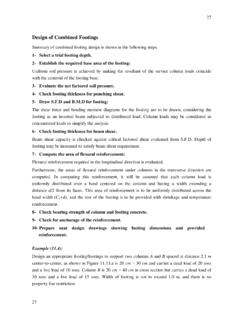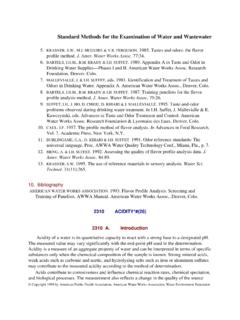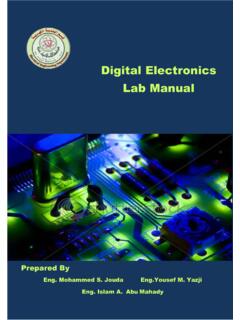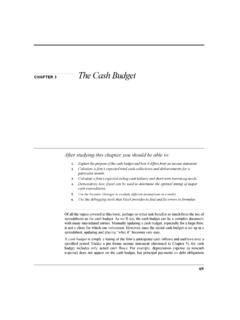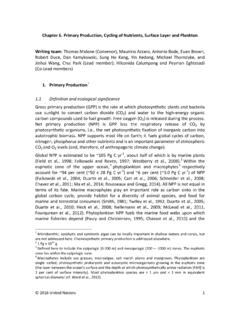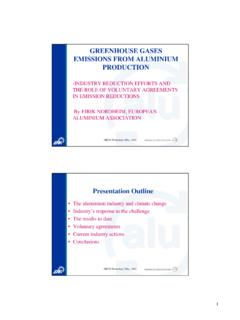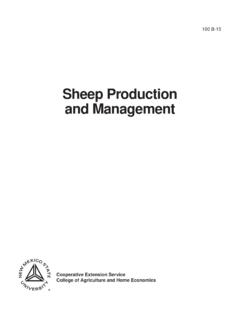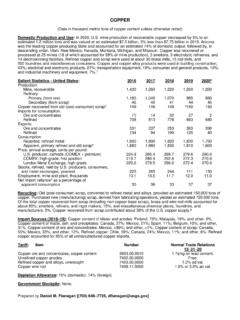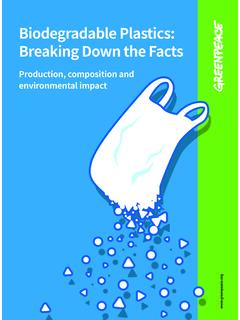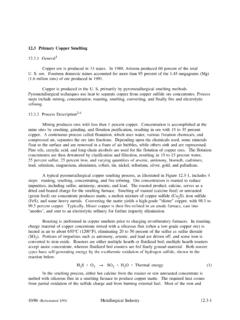Transcription of Marine Primary Productivity: Measurements and Variability
1 Marine Primary productivity : Measurements and Variability Why should we care about productivity ? Photosynthetic activity in oceans created current O2-rich atmosphere Plankton form ocean sediments & fossil fuels Plankton are a critical part of carbon pump that influences atmospheric CO2 Phytoplankton form the base of food webs and associated biological diversity Limits to productivity may limit the amount of harvestable biomass from ocean ecosystems. productivity is the amount of living tissue produced per unit time. It is often estimated in terms of carbon contained in living material and expressed as grams of carbon (g C) produced per day, in a column of water intersecting one square meter of sea surface (g C m-2 d-1), from the surface to the seabed. Primary productivity is the amount of plant tissue build up by photosynthesis over time.
2 It is so called because photosynthetic production is the basis of most of Marine production . It is worth to mention here that there are other types of Primary production that are carried out by bacteria capable of building organic materials through chemosynthetic mechanisms, but these are of minor importance in the oceans as a whole. Gross Primary productivity is the total amount of organic carbon manufactured by Primary producers. Primary producers however, immediately respire some of the organic matter they make to meet their own energy needs, so it is not available as food to other organisms. We are more interested, however, in Net Primary production , which is the organic matter that is left over or the carbon that is available to higher trophic levels.
3 Net Primary production is also defined as the energy remaining after respiratory needs have been met. Net Primary production = Gross Primary production - Respiration Net Primary production by photosynthesis can be estimated by measuring either the amount of raw material used up (CO2 ) or the amount of end products given off (O2) by photosynthetic organisms in the sunlight. Marine ecologists have attempted to develop accurate and relatively simple methods to estimate Primary production . Secondary productivity refers to production by the organisms that consume the phytoplankton; and those that consume the organisms responsible for secondary production are said to be engaged in tertiary productivity . Standing stock or standing crop refers to the number of organisms per unit area or per unit volume of water at the moment of sampling.
4 For phytoplankton, this can be measured by microscopic cell counts of preserved phytoplankton filtered from seawater samples, and the standing stock is given in number of cells per volume of water. However, because phytoplankton vary greatly in size, total numbers are not as ecologically meaningful as estimates of their biomass. Biomass is defined as the total weight (total numbers average weight) of all organisms in a given area or volume. It is possible to count numbers and measure volumes of phytoplankton electronically to provide an estimate of phytoplankton biomass, although cell volume may not always accurately reflect cell weight. Biomass is then expressed as the total volume (total numbers volumes = mm3) of phytoplankton cells per unit volume of water. The distinction between standing stock and biomass is not always made evident, however, and often the terms are used synonymously.
5 Measuring Primary productivity Oxygen Technique The oxygen technique relies upon the fact that oxygen is released in proportion to the amount of photosynthesis. Because oxygen is released during photosynthesis, changes in oxygen concentration can be used to estimate Primary productivity . A water sample is first collected and the zooplankton are strained from it, using a 150-300 m plankton net. The remaining water is divided into two biological oxygen demand (BOD) bottles and the dissolved oxygen is determined. One bottle is covered with dark paper while the other is left uncovered (Figure ). Both bottles are incubated in the light for several hours. Dissolved oxygen is measured at the end of the experiment. Fig. measurement of photosynthesis with light and dark bottles at various depths.
6 Fig. measurement of Primary production in seawater samples by using light and dark bottles The clear bottle allows light to enter, so both photosynthesis and respiration take place, whereas the dark bottle provides data on respiration only. Thus, the amount of oxygen produced in clear bottles reflects the net Primary production . To calculate the total or gross Primary production of organic matter by photosynthesis the amount of respiration must be known. This can be measured from the amount of oxygen used up in the dark bottle, where only respiration occurs because the light is blocked (gross Primary production = net Primary production + respiration). This light-dark bottle technique can be also applied by incubating in various levels of artificial light, or by actually dropping a string of bottles over the side and incubating them in natural light (Figure ).
7 With the artificial light technique, it is necessary to measure the light intensity as a function of depth, so that the Measurements can be used to calculate the amount of photosynthesis in the natural environment. Practically speaking, respiration is often not actually measured, but is usually taken to be a value that corresponds to 10 percent of the total oxygen increase. Chlorophyll extraction method A known volume of water is filtered, and plant pigments are extracted in acetone (or other organic solvent) from the organisms retained on the filter. The concentration of chlorophyll a is then estimated by placing the sample in a spectrophotometer to measures the extinction of different wavelengths in a beam of light shining through the sample. Fluorometer technique Instead spectrophotometer an instrument called a fluorometer can be used for measuring chlorophyll concentration in acetone extract from its fluorescence.
8 A fluorometer produces a certain wavelength of ultraviolet light which will cause chlorophyll to emit a red fluorescence, and this device can then estimate the amount of chlorophyll in a volume of water. Compared to spectrophotometer, fluorometer is more sensitive, it requires less sample, which may make it a better choice for chlorophyll analysis in less productive, ultra-oligotrophic systems. The Pump and Probe Fluorometer PumpProbe Fluorometer is a submersible double-flash pulse fluorometer for continuous measurement of chlorophyll concentration and photosynthesis rate in situ. The method is very sensitive, and a fluorometer towed from a research vessel can rapidly record changes in chlorophyll concentration over large distances of sea surface Radiocarbon Technique The most popular method of measuring productivity in the sea is the 14C method.
9 In this method, bicarbonate ion is labeled with the radioactive isotope of carbon, 14C (The common nonradioactive isotope is 12C.) A small measured amount of radioactive bicarbonate (HCO3-) is added to two bottles of seawater containing phytoplankton. One bottle is exposed to light and permits photosynthesis and respiration; the other is shielded from all light so that only respiration takes place. The amount of radioactive carbon taken up per unit time is later measured on the phytoplankton when they are filtered out of the original samples. This radioactivity is measured in an instrument known as a scintillation counter, and Primary productivity (in mg C m-3 h-1) is calculated from: ()rate of production =LDRRWRt where R is the total radioactivity added to a sample, t is the number of hours of incubation, RL is the radioactive count in the 'light' bottle sample, and RD is the count of the 'dark' sample.
10 W is the total weight of all forms of carbon dioxide in the sample (in mg C m-3), and this is determined independently, by, for example titration. The productivity is expressed as the amount (in mg) of carbon fixed in new organic material per volume of water (m-3) per unit time (h-1). The radiocarbon technique is preferable in waters of low productivity , because of the very low changes in oxygen concentration during photosynthesis. Satellite Color Scanning Another method commonly used by scientists is satellite imagery which provides even broader spatial coverage of phytoplankton abundance and thus productivity . This technique is based on the fact that the radiance reflected from the sea surface in the visible spectrum (400-700 nm) is related to the concentration of chlorophyll.
